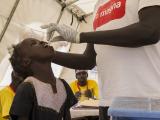May 31, 2012 (CIDRAP News) – A nationwide Salmonella outbreak linked to one US poultry hatchery has continued for 8 years, illustrating both the risk that chicks can pose to children and the difficulty of ridding hatcheries of the pathogen, according to a report released yesterday in the New England Journal of Medicine.
The outbreak involved 316 cases in 43 states from 2004 through 2011. Among patients who were interviewed, 23% were hospitalized and 55% had bloody diarrhea. After the hatchery took a number of steps to eliminate the contamination, the number of cases dropped, but they didn't disappear.
The report comes as the Centers for Disease Control and Prevention (CDC) and other agencies track another Salmonella outbreak linked to a mail-order poultry hatchery, located in Ohio, with 93 cases reported in 23 states as of yesterday (see separate news item).
The long-running investigation involved experts from the CDC, several state health departments, the US Department of Agriculture (USDA), and Pfizer Animal Health in Overland Park, Kan.
In 2009 the United States had 20 mail-order hatcheries that shipped about 50 million live poultry, which brought in between $50 million and $70 million, the report says. Sales that year set new records, fueled by growing interest in raising backyard flocks and "urban chickens."
The outbreak was detected by Colorado disease detectives in April 2005, when three patients reported exposure to chicks or ducklings bought from farm feed stores in the week before they got sick. The cases involved Salmonella enterica serotype Montevideo with matching DNA fingerprints (pulsed-field gel electrophoresis patterns). The strain was rare, but another five cases were soon found in four other states.
Investigators looked for outbreak-strain cases with data deposited in the CDC's PulseNet database beginning in 2004 and continuing through 2011. The total reached 316 cases from 43 states, with illnesses peaking each spring. With ages available for 266 patients, the median age was 4 years, and 54% of patients were under age 6.
The researchers managed to interview 156 patients or their caretakers. Thirty-six of these (23%) were hospitalized for a median of 2 days, and 80 of 145 patients (55%) with available information had bloody diarrhea.
Seventy-seven percent of those with available information reported contact with live young poultry in the week before they got sick. In the interviews, only 16 of 76 (21%) patients or guardians said they had known they could acquire Salmonella through contact with poultry, and 5 (7%) reported receiving a warning about that when they bought the poultry.
The researchers traced the hatchery sources of live poultry found in the homes of 59 case-patients. In 48 cases (81%) the poultry were traced to the same hatchery, which was not identified but is located in the West.
The hatchery ships up to 250,000 birds per week in the spring, the report says. In 2006, after consulting with experts, the hatchery took a number of safety steps, such as changing airflow, adopting a new egg-cleaning procedure, conducting routine surveillance for Salmonella, and vaccinating all adult chickens.
Cases in the outbreak peaked at 84 in 2006 and then, in the wake of the safety interventions at the hatchery, declined for 3 years before jumping back up to 57 in 2010 and then subsiding to 29 in 2011. In the first 4 months of this year, only one case of the outbreak strain was identified. Of 200 environmental samples from the hatchery that were tested in 2008 and 2009, 14 were positive for the outbreak strain.
The resurgence of cases in 2010 was most likely caused by a temporary lapse in safety procedures, the authors speculate. But they say the outbreak strain probably persisted in the hatchery during the whole 8-year investigation, particularly since its breeding facility does not bring in any birds from outside flocks. The hatchery has continued to work with public health officials and other experts to strengthen its Salmonella prevention measures.
"The current investigation shows that control interventions at mail-order hatcheries can play a role in the reduction of salmonella transmission," the researchers write. It also shows that "consumers are often unaware of the risk of salmonellosis from exposure to live poultry and are not adequately warned at the time of purchase."
To limit the risk of the illness, the authors advise that consumers should use "meticulous hand hygiene." In addition, high-risk groups, including children under age 5 and the elderly, should not touch any live poultry, including chicks, and live birds should not be brought inside houses and in particular should be kept out of bathrooms, kitchens, and dining areas.
Gaffga N, Behravesh CB, Ettestad PJ, et al. Outbreak of salmonellosis linked to live poultry from a mail-order hatchery. N Engl J Med 2012 May 31;366(22):2065-73 [Abstract]
















